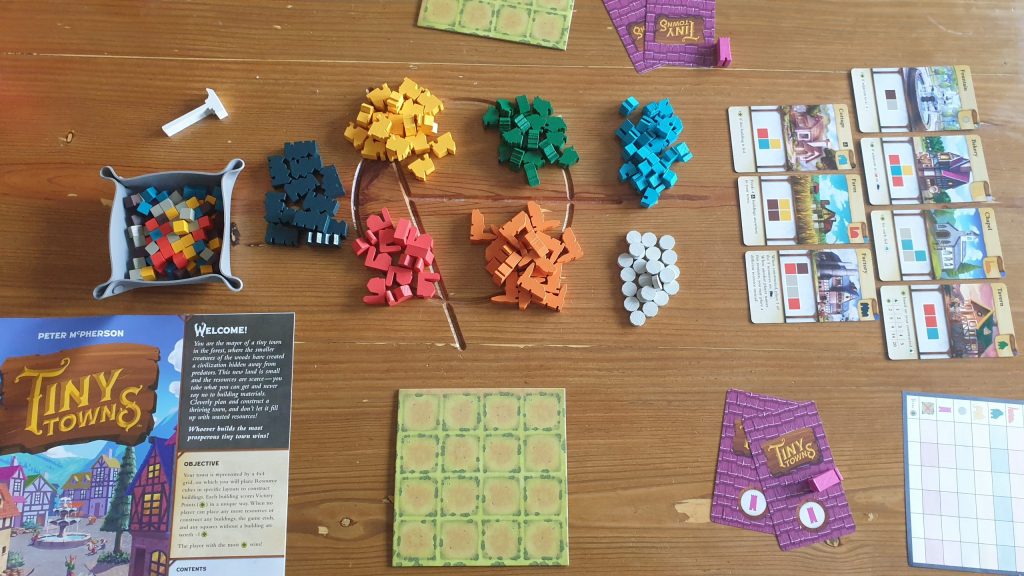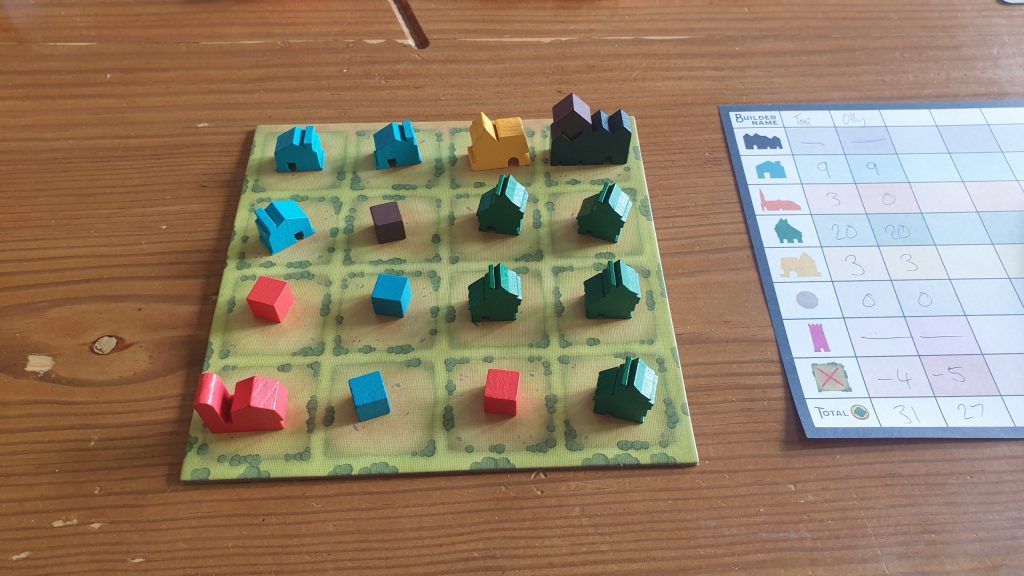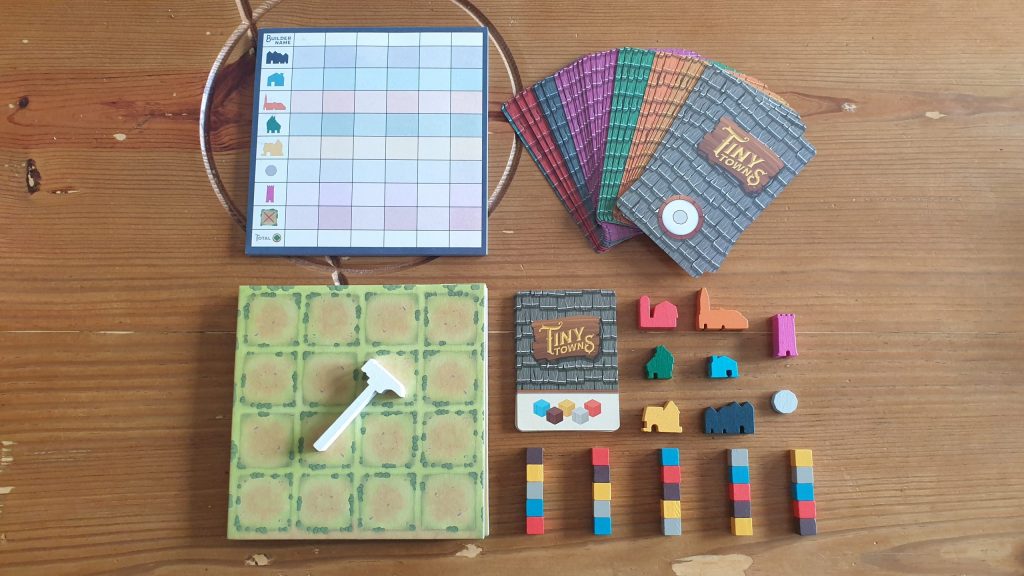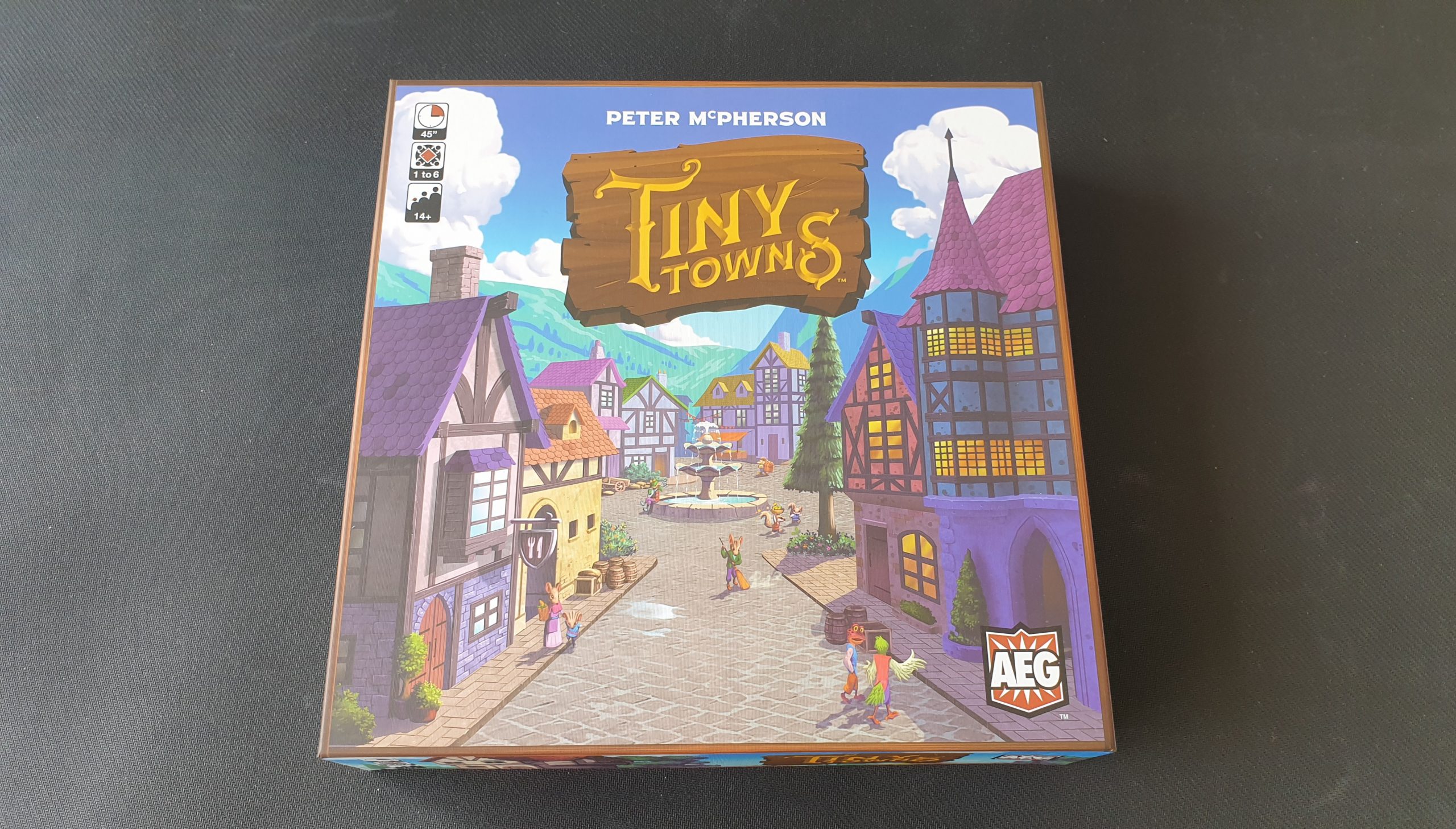Tiny Towns is an abstract strategy board game from publisher AEG, where creating patterns with resources helps construct city buildings. Designed by Peter McPherson, the game sees 1 – 6 players adding resources to their personal gridded payer boards, before trading them in for a range of point scoring buildings. Taking around 45 minutes the aim is to create a wonderful town for the small forest creatures. However, will Tiny Towns captivate players? Let’s find out!
Starting out players will need to decide which buildings will be in play for the game, with the cottage always being one of them. For each of the 7 building types a tarot sized card is selected. These 7 cards denote a pattern and ability – alongside the name of the building and artwork. After an initial game you’ll want to then deal out two monument cards to each player, to choose one of. The building pieces are placed in piles within reach, with each player claiming one monument piece if including them. Aside from grabbing a player board and putting the resource cubes within reach the game is ready to go!
Players will be adding resources to their personal boards, each time adding a cube to an empty space on their 4×4 grid. Based upon the patterns of resources these cubes can be exchanged for a building piece. The aim is to fill the board with point scoring buildings and have as few empty spaces as possible. The way the game works is that the active player becomes the Mayor for the turn. They can state any resource type they wish and all players must add a cube of that type (colour) to their board.
If at this stage anyone has resource cubes in a pattern matching one of the building cards they can construct it by spending the cubes. The building must be placed onto one of the spaces that the cubes came from. A few rules apply such as the pattern must match, though players can rotate and flip it. This is an optional action, as players may choose not to build, with them also able to construct multiple buildings at once. For example, the Well requires a brown (Wood) and a grey (Stone) cube to be adjacent (excluding diagonals). If a player has this configuration they can spend the two cubes to construct a well – which earns the player 1 point for adjacent cottage at the end of the game. This can be done by all players, not just the mayor, with the mayor role then passing onto the next player.

Each player can keep playing until their board is completely full, either of cubes, buildings or both. If the player cannot place a cube, and this must be done before construction on a turn, then they are out of the game. Eliminated players can no longer become the mayor, though for the rest of the players the game continues. When all players are out it is time to score. Firstly, all cubes that were left on players’ boards are removed, leaving empty spaces. Using the included scoresheet, players calculate the points earnt from each type of building. They subtract a point for each empty space on their player board, before the person with the most points is revealed.
Tiny Towns has a variant method in the rules called Town Hall. In this mode players shuffle a deck and, after discarding the top 5 cards, use it to choose what resource players must take on a turn. To make it not entirely random this method uses a 2:1 cycle. After two cards have been flipped the third round players can freely choose what colour cube to add to their board – with the choice not impacting the others. This cycle continues until the deck runs out when it is reshuffled and the game continues. If the game wasn’t already, this method makes the game more of a multiplayer solitaire experience, and is actually the method used for the solo variant. Aside from structures that may score differently based on opponents, there is then no need whatsoever to look at what others are doing.
Players have been rather split over the two methods for choosing cubes. The standard method leaves the door wide open for a rather take that style of game. Lifting your head from your personal board, it’s easy to spot what others might want and what they might choose on their turn. For example, if a player is building a lot of cottages and they have a red and blue cube on their player board, chances are they will say yellow on their turn. With this knowledge you can work around that or work it into your plans. It isn’t a direct interaction. Still, this means you can screw an opponent over, by forcing them to take colours that they don’t want to use.
The card method does lend itself to playing over the internet or with larger groups. When getting above 3 the normal method gives players increasingly less choice about what is added to their player board. In turn this makes players feel like they are having less impact on the game, being reliant on tactically reacting to what is thrown at them. This reaction is there with the Town Hall method but at least every third turn you get a choice. With the full player count of 6 you could have 5 coloured blocks that you don’t want given to you before it’s your turn again.

The variety of building cards in Tiny Towns instils a huge amount of variety and replayability into the title, even without adding in monuments. Changing out only a couple of these from one round to the next can often see wildly different strategies employed. In one game it may be easy to feed a lot of cottages, so they offer a high point scoring opportunity. In the next game players might score big with groupings of other buildings, as unique building types in a row might be beneficial. On top of buildings the monuments add another layer of choice. Some will be rushed into construction, to get the most out of the unique power. Others will be squeezed in mid-game when they are already guaranteed to score some points. It is remarkable how different two games can be, with only the cottage needing to stay in play from one game to the next.
The production of Tiny Towns cannot be faulted. The cubes are all of distinct, easy to distinguish, colours. The buildings where the colours aren’t as varied then come in a huge amount of shapes, allowing them to be identified at a glance thanks to their silhouettes. The building cards are all of large tarot like size, clearly indicating which building piece they correspond with. All of this makes playing trouble free, leaving players to solve the puzzle of placing resources rather than trying to understand it.
The only minor issue comes when players are too eager to remove resources to add a building. In the first couple of games there were some awkward moments when the cubes were removed but players then weren’t 100% sure which spaces they came from. In an app you could imagine the spaces being highlighted where the building could be placed, which obviously doesn’t occur in real life. Tweaking the build order from the rulebook to claiming the building piece before removing the cubes seemed to avert this mild awkwardness, and is how I’d teach the game moving forward.
When it comes to the theme of Tiny Towns it is a pleasant one. A few aspects of the game make sense because of it. For example, the red buildings that relate to providing food for cottages are farms, orchards and such. For the most part though the theme isn’t really there. There isn’t a sense of building up a town for forest creatures. It is an abstract game where the patterns of resources mean more to players. At the end of play the buildings are never looked at as more than point scoring opportunities, regardless of their cuteness.

It says a lot about a competitive game when you can lose but still feel you have managed something, and you enjoyed the experience. While sometimes I have been close to winning, and at times I’ve been thrashed, I haven’t managed to pull off a win yet. Despite this, the puzzle presented has always been an interesting one, and one with plenty of variety to keep the game fresh. The two resource choosing methods are both valid, and while the normal method gives more interaction, over 4 players I’d recommend sticking to the Town Hall deck method. Overall, Tiny Towns is a game you’ll keep wanting to come back to, and one day I’ll even (hopefully) manage to win!
(Editor’s Note: Tiny Towns was provided to us by Asmodee for the review. The game is currently available from local board game stores, some of which are reopening! Find your local store here.)

